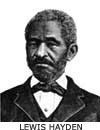|
African-Americans in Antebellum
Boston
 From
these somewhat modest beginnings has grown a project that has
become an archival collaboration including digitized documents
from the Boston Athenaeum, Massachusetts Historical Society,
Massachusetts State Archives, Massachusetts State House Special
Collections, City of Boston Archives, and the American Antiquarian
Society. From
these somewhat modest beginnings has grown a project that has
become an archival collaboration including digitized documents
from the Boston Athenaeum, Massachusetts Historical Society,
Massachusetts State Archives, Massachusetts State House Special
Collections, City of Boston Archives, and the American Antiquarian
Society.
Our first step was to develop a searchable
database of African-Americans living in the neighborhood around
the time of 1850. We began with Boston city directories
which listed the names, occupations and addresses of adult residents
of Boston. Although race is not one of the categories listed,
these directories had separate lists for "People of Color"
until the 1849-50 city directory. Ironically, this segregation
made it easy to develop an initial
database including street addresses. Starting with the 1849-1850
directory, it was difficult to tell which residents were black.
The 1850 United States Census Population Schedule was helpful
to this end. We purchased a CD-ROM of the Census and began looking
through
digitized copies of the original enumeration. We found the
enumeration districts for Beacon Hill and the West End, which
closely correspond to the political wards of the city. The 1850
Census allowed our database to expand to include categories
such as age, sex, race, occupation, value of real estate, place
of birth, and ability to read and write. The students printed
copies of the original enumeration sheets from the CD-ROM and,
using
blank census forms, began the laborious process of transcribing
and typing all of the individual demographic data from the African-Americans
that were listed. This process was painstaking as the writing
of the original enumerators was in cursive and was in many cases
difficult to read. Any questionable transcriptions of names
were searched on the CD-ROM, which has a name index, for verification.
Although the 1850 census expanded the categories of our database
it omits one important category that the city directory does
not: the street address. This was problematic since a study
of a neighborhood should include addresses to answer questions
such as:
1. Was the neighborhood racially mixed?
2. Was it segregated by race, occupation, or place of birth?
3. Who owns the specific houses?
4. Is the neighborhood static or dynamic over time?
 Using
Tax Records Using
Tax Records
|
Untitled Document
|